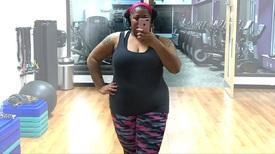Why bother with stregth training

FearlessRobb
Posts: 249 Member
You enter it in but it doesnt affect calories and doesnt tell u anything but what u did. Adding in cardio shows calories burned why doesnt stregth????????
0
Replies
-
You can enter it in cardio as strength training and it'll give you calories.
The strength training area below is more to log your lifts (number of pounds, reps, etc.)0 -
This is where a Heart Rate Monitor comes in handy.0
-
Strength training makes your body stronger.0
-
I think it's because it's really hard to estimate how many calories someone burns through strength training - there are so many variables. But yeah, you can enter it as cardio for a rough estimate. Also, there are many advantages to strength training regardless of calorie burn.0
-
HRMs aren't really very accurate for that type of exercise, they're really best for steady-state cardio.This is where a Heart Rate Monitor comes in handy.0 -
i second the HRM comment. plus the MFP cals are usually wayyy off. they can say in 20min on treadmill i'll burn x amount of calories, when in reality is half of that.
also, when i strength train i burn about 400 calories per hour...so yeah, strength train.
plus muscle is sexy AND burns more cals per day than fat, why wouldnt you want to strength train haha0 -
It's hard to work out how many calories strength training will actually burn - as it keeps 'burning' for over 24 hours after I believe, even though at the time you won't have burnt that many.
Why do it - look in the mirror after a couple of months and lower fat/more tone is the incentive.0 -
There's a strength training entry in the cardio section. It's just a ballpark, but it gives me about 89 calories per half hour.0
-
Well there are various reasons. One is that, ideally, you want to lose primarily fat and maintain as much lean muscle tissue as possible. This is very difficult without strength training whlie in calorie deficit and lean muscle tissue will be lost. This is why sometimes people diet and do cardio and reduce their overall weight but don't drop thier body fat % as much.
Another is that, while strength training doesn't burn a ton of calories while doing it, it has the highest "afterburn" or EPOC (Excess Post-exercise Oxygen Consumption). This gives you an increased metabolism for a period of time after exercise where you continue to burn calories at a higher level.
For these reasons, the ideal strategy for getting healthier and leaner is a combo of calorie deficit, strength training and cardio in that order of priority.0 -
i second the HRM comment. plus the MFP cals are usually wayyy off. they can say in 20min on treadmill i'll burn x amount of calories, when in reality is half of that.
also, when i strength train i burn about 400 calories per hour...so yeah, strength train.
plus muscle is sexy AND burns more cals per day than fat, why wouldnt you want to strength train haha
I agree with the cals being way off the actual 10 min on a treadmill at 2.5 walking pace burns about 50cal but on MFP it says like 200cal.0 -
This is where a Heart Rate Monitor comes in handy.
HRMs are designed for cardio and fairly useless for strength training.0 -
I have a HR monitor and I just enter the whole time and the calories burned in a cardio. I'm not going to bother adding in the reps and things. What a pain and a bore.0
-
Well there are various reasons. One is that, ideally, you want to lose primarily fat and maintain as much lean muscle tissue as possible. This is very difficult without strength training whlie in calorie deficit and lean muscle tissue will be lost. This is why sometimes people diet and do cardio and reduce their overall weight but don't drop thier body fat % as much.
Another is that, while strength training doesn't burn a ton of calories while doing it, it has the highest "afterburn" or EPOC (Excess Post-exercise Oxygen Consumption). This gives you an increased metabolism for a period of time after exercise where you continue to burn calories at a higher level.
For these reasons, the ideal strategy for getting healthier and leaner is a combo of calorie deficit, strength training and cardio in that order of priority.
Agree w/ all this.
I kind of thought he was asking "why bother logging it" not "why bother doing it", but if so, big YES to this.0 -
I'm pretty sure that's what he was asking, yeah. MFP is more about tracking food and cardio than tracking weights, but they give you the option to.I kind of thought he was asking "why bother logging it"0 -
I'm pretty sure that's what he was asking, yeah. MFP is more about tracking food and cardio than tracking weights, but they give you the option to.I kind of thought he was asking "why bother logging it"
Yes my main thing is why bother logging it lol0 -
This is where a Heart Rate Monitor comes in handy.
HRMs are designed for cardio and fairly useless for strength training.
This.
Also, while strength training might not burn many calories while you're doing it, it will help you burn more calories when you're just sitting around. This is because you'll have more lean body mass, which is more metabolically active than fat. Thus, your calories burned at rest will be higher than if you did no strength training.
Case in point: a man can eat more calories than a woman, all other factors equal (height, weight, ect.). Why? Because men naturally have more lean body mass than women.0 -
This is where a Heart Rate Monitor comes in handy.
sigh.......I've already gotten by once weekly rant about HRMs out so I'll leave this alone.
Pretty sure he means that logging it in MFP is a waste of time. And yep, pretty much it is. Don't log exercises, sets or reps. Hell, don't ever touch the Strength Training tab. It's a waste of time. You can, if you wish, log strength training as an exercise under cardio. It'll give you a meaningless calorie burn number, but mostly it will be a way to track what you did on each day in broad strokes.
If you do want an app to track your strength training progress, I strongly recommend Jefit. Big improvement over my pad and pencil days.0 -
This is where a Heart Rate Monitor comes in handy.
HRMs are designed for cardio and fairly useless for strength training.
Lies! HRMs are at least 99.44% accurate for everything. Always.0 -
This is where a Heart Rate Monitor comes in handy.
HRMs are designed for cardio and fairly useless for strength training.
Lies! HRMs are at least 99.44% accurate for everything. Always.
I thought it was 99.42?
Anyway, I wear mine while sleeping and eat back my sleep calories....0 -
strength training will make you look good naked...
just doing cardio will make you a smaller, mushy, same shaped person...0 -
HRMs aren't really very accurate for that type of exercise, they're really best for steady-state cardio.This is where a Heart Rate Monitor comes in handy.0 -
My HRM is fairly accurate when it comes to strength training, I do cardio then strength then cardio then strength and so on so I'm always moving and my HR is always up.
I'd say get one and try it out, make sure it's one that has a chest strap though.0 -
If the query is why bother logging it (as opposed to why bother doing it) the answer for me is that is a useful record of weights and reps which I may wish to look back on in the future.
I'm pretty sure that's what he was asking, yeah. MFP is more about tracking food and cardio than tracking weights, but they give you the option to.I kind of thought he was asking "why bother logging it"
Yes my main thing is why bother logging it lol0 -
You can enter it in cardio as strength training and it'll give you calories.
The strength training area below is more to log your lifts (number of pounds, reps, etc.)
THIS is the answer right here! You have to log strength as cardio. When you enter strength as strength, it's just for tracking purposes.0 -
If you lift 100 pounds of weight one foot, you've done 100 foot-pounds of 'work' which equals 0.032 calories.
Do 10 reps and you've burned about 3/10 of a calorie.
You'll burn almost as much keeping track and then logging it into MFP.0 -
My HRM is fairly accurate when it comes to strength training, I do cardio then strength then cardio then strength and so on so I'm always moving and my HR is always up.
Out of curiosity, how do you know it's "fairly accurate"? What is this based on?0 -
Strength training does not include calories because there is not really a formula that would cover all body types, how the training technique is preformed, the energy that each individual puts into it etc. which basically varies to each individual on any given day. But you can enter your program into the cardio section if you know how many calories you are expending during the strength training activity in order to track your total calorie count if you so wish. There is information available that will tell you what a typical workout activity will burn but not sure how accurate it would really be but it may ball park it to give you a rough idea.0
-
I have been a runner for a long time and I didn't think strength training did anything for you either. But I have read several articles that said strenth training will increase your metabolism faster than running, so they made a believer oyt of me0
-
If you do want an app to track your strength training progress, I strongly recommend Jefit. Big improvement over my pad and pencil days.
Thanks! I was actually looking for something better than my notebook :flowerforyou:0 -
You enter it in but it doesnt affect calories and doesnt tell u anything but what u did. Adding in cardio shows calories burned why doesnt stregth????????
Are you trying to say that MFP's exercise calories are accurate and strength training accomplishes nothing so why bother? I want to come up with analogy for why this is so absolutely ridiculous but I think it'll just cause an aneurysm.
OK, to stop being rash and move to informative:
First and foremost, resistance training burns more energy that cardio. Period. This is not debatable.
Second, calories burned during cardio begin and end with exercise. On the other hand strenght training is a continual metabolic process of 3 phases durating anywhere from 6-48 hours. The inital workout burns massive amounts of energy then the rebuilding/recovery process also utilizes calories, now that you've increased lean muscle tissue either in size, density or shape you will require MORE energy to maintain this lean body mass.
Third, endocrine function in regards to resistance training also support the processes of fatty acid oxidation through release of important anabolic hormones such as testosterone, glucagoan, epinepherine, norepinepherine, IGF, seretonin, and the suppression of things like ghrelin. Other cell signals such as AMPK, GLUT4, and cAMP are also increased during resistance training and peak in a post-workout phase where somatic muscle tissue is in a state of insulin sensitivity and enabeling storage of nutrients into the liver and muscle instead of hanging around the blood stream or depositing into adipose tissue.
I could go on and on but why bother?0
This discussion has been closed.
Categories
- All Categories
- 1.4M Health, Wellness and Goals
- 398.5K Introduce Yourself
- 44.7K Getting Started
- 261K Health and Weight Loss
- 176.4K Food and Nutrition
- 47.7K Recipes
- 233K Fitness and Exercise
- 462 Sleep, Mindfulness and Overall Wellness
- 6.5K Goal: Maintaining Weight
- 8.7K Goal: Gaining Weight and Body Building
- 153.5K Motivation and Support
- 8.4K Challenges
- 1.4K Debate Club
- 96.5K Chit-Chat
- 2.6K Fun and Games
- 4.8K MyFitnessPal Information
- 18 News and Announcements
- 21 MyFitnessPal Academy
- 1.5K Feature Suggestions and Ideas
- 3.2K MyFitnessPal Tech Support Questions



















